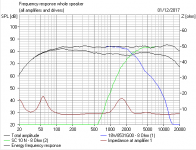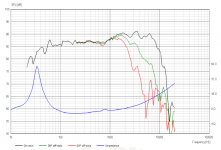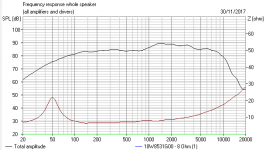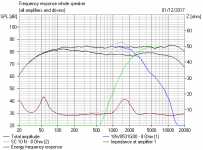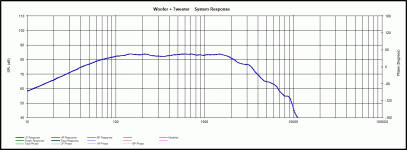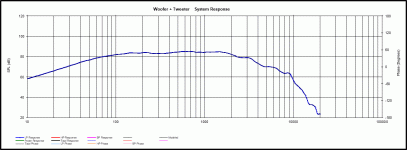I have considered this terrible sliced paper Scanspeak 18W-8531-G00 woofer for some time.
You people may buy as many microphones and test-gear as you like, but if you don't have a good idea, you are lost!
I have actually knocked it into shape. Which, IMO is doing considerably better than US Zaph or Scandinavian Troels Gravesen, who frankly, landed flat on their backsides with this one.
I can't possibly discuss how I did this, because I might make money out of this and it's applicable to 5" bass too. But it was not rocket-science. 😀
Observe the comfortable 2.5kHz higher crossover. The lack of shout on vocals. Clever stuff. We don't care if it's MT or MTM or MMT. You can't teach that in school. I throw in Boxsim's import modelling from Zaph's own measurements to assure you I am not completely off the wall. 😎
You people may buy as many microphones and test-gear as you like, but if you don't have a good idea, you are lost!
I have actually knocked it into shape. Which, IMO is doing considerably better than US Zaph or Scandinavian Troels Gravesen, who frankly, landed flat on their backsides with this one.
I can't possibly discuss how I did this, because I might make money out of this and it's applicable to 5" bass too. But it was not rocket-science. 😀
Observe the comfortable 2.5kHz higher crossover. The lack of shout on vocals. Clever stuff. We don't care if it's MT or MTM or MMT. You can't teach that in school. I throw in Boxsim's import modelling from Zaph's own measurements to assure you I am not completely off the wall. 😎
Attachments
Scanspeak 18W-8531-G00
hi Steve,
Could you elaborate on your specific concerns towards these Scanspeak revelators?
hi Steve,
Could you elaborate on your specific concerns towards these Scanspeak revelators?
My specific "concern" or, er, "issue", in the current C21 politically correct and inoffensive gibberish language, that we have so got used to that we don't question it anymore, is that the Scanspeak 18W-8531-G00 Revelator is a dreadful overpriced driver. Rubbish. Poor. Wrong. 😱
I mean, there is a lot to like in solid cast chassis, copper damping rings and low inductance. But really, getting the kids to slice the cone with a Stanley knife and glueing it back together before I get home to notice, is testing MY patience. 🙄
But maybe hardware problems are fixable in software. I found this so. I got rid of the Scanspeak's worst 1.5kHz midrange shout easily enough. But if I told you how, I'd have to shoot you. 😀
Clue: The dotted line is SS on a second-order filter. My simple fix is the solid line. 😎
I mean, there is a lot to like in solid cast chassis, copper damping rings and low inductance. But really, getting the kids to slice the cone with a Stanley knife and glueing it back together before I get home to notice, is testing MY patience. 🙄
But maybe hardware problems are fixable in software. I found this so. I got rid of the Scanspeak's worst 1.5kHz midrange shout easily enough. But if I told you how, I'd have to shoot you. 😀
Clue: The dotted line is SS on a second-order filter. My simple fix is the solid line. 😎
Attachments
Last edited:
I don't want to take this poor horse carcass out of another thread, and replace it here, but as I am listening to the 18W/4531 right now in two ways crossed around 2kHz, I want to repeat, Steve's issues with this series is not something I can corroborate. I love mine and plan to die listening to them.
E
E
I had a pair of 3-ways with the SS 8545-01 to try out for a week, yea that's an amazing woofer, but with a $175 price tag.
It can't out do dual $65 woofers in a box, but pretty close!!
It can't out do dual $65 woofers in a box, but pretty close!!
I have actually knocked it into shape. Which, IMO is doing considerably better than US Zaph or Scandinavian Troels Gravesen, who frankly, landed flat on their backsides with this one.
Please expand...
Alex
You mean a bit like this Steve?
This is using John's (Zaph's) measurements, but I quickly simulated a simple baffle & its step-loss + diffraction & added that in. I confess, I have had to use 3 components to hit this (roughly 2nd order Butterworth @2.1KHz) target slope. Not precisely the same acoustic slopes as your own, & it would need more work, but I only had a couple of minutes & if we're talking about 'knocking the 8531 into shape' it isn't a bad starting point.
This is using John's (Zaph's) measurements, but I quickly simulated a simple baffle & its step-loss + diffraction & added that in. I confess, I have had to use 3 components to hit this (roughly 2nd order Butterworth @2.1KHz) target slope. Not precisely the same acoustic slopes as your own, & it would need more work, but I only had a couple of minutes & if we're talking about 'knocking the 8531 into shape' it isn't a bad starting point.
Attachments
Last edited:
Ophelia measurement seems flat on the #1 post if measured at 50" on axis ! Should be very smooth at listening position.
Many SS drivers have this bump above 1k to 1K5 Hz ! What is the origin of that behavior ! How to tame it in the filter? C//R in serie on the signal of the driver ?
Btw, have googled a little with this thread and indeed the Illuminator seems clearer and have further détails... But, all those high end speakers with Revelator are a good sign,no ?
Many SS drivers have this bump above 1k to 1K5 Hz ! What is the origin of that behavior ! How to tame it in the filter? C//R in serie on the signal of the driver ?
Btw, have googled a little with this thread and indeed the Illuminator seems clearer and have further détails... But, all those high end speakers with Revelator are a good sign,no ?
Many SS drivers have this bump above 1k to 1K5 Hz ! What is the origin of that behavior !
There's a minor spike in H2 associated with it; that is usually related to an edge reflection and / or movement in 2 directions i.e. a minor discontinuity / resonance in suspension behaviour.
How to tame it in the filter? C//R in serie on the signal of the driver ?
Depends what you're trying to do. In the case above, I simply used a conventional Rl shelving high pass followed by a shunt cap. The target slope & transfer function is sufficient to flatten it.
Btw, have googled a little with this thread and indeed the Illuminator seems clearer and have further détails... But, all those high end speakers with Revelator are a good sign,no ?
Different drivers, different objectives. The Revlelators are older designs & purely IMO have a balance of properties that I prefer for paper cone designs. I don't much like the Illuminator woofers, excellent though they are in some ways.
Yes, not that I would let that make a decision for me. High end commercial speakers often use expensive drivers, but that doesn't mean they all use them optimally. Many do. Many don't (keeping in mind that most have somewhat different objectives WRT voicing). Forget what they're doing; what you need to know is what you already know: the Revelator woofers have a decently usable FR, high quality motor & basket, very low HD, low energy storage overall and are overall excellent examples of paper cone drivers.
Last edited:
I have posted my own measurements on the 18W/4531. It is not nearly as bad as the spec. I'm not sure if this is a production change, but the FR chart is terribly pessimistic. Please ignore it. 🙂
Why we should ? the bump beginns sometimes at 1K Hz while in the other sense the baffle step beginns its bad behavior let diving the curve towards the mid & low !
look at this SS 10F 8 ohms ! the snail travelling on the flat curve is stopped towards 1 K as if he was seeing Everest ! Illuminators and revelator of close size are even more bumpy....
look at this SS 10F 8 ohms ! the snail travelling on the flat curve is stopped towards 1 K as if he was seeing Everest ! Illuminators and revelator of close size are even more bumpy....
Attachments
I really need to spend time away from this forum and come back when there are more nice people to talk to.
Is it me ?
Maybe you're just a little tired, don't want to hurt you but your words in your last sentence are agressiv, not mine ! Being nice doesn't mean to agree always with you. Anyway, was not writed to hurt you.
Maybe you're just a little tired, don't want to hurt you but your words in your last sentence are agressiv, not mine ! Being nice doesn't mean to agree always with you. Anyway, was not writed to hurt you.
Last edited:
Why we should ? the bump beginns sometimes at 1K Hz while in the other sense the baffle step beginns its bad behavior let diving the curve towards the mid & low !
No, it's not bad behaviour. The 10F is a wideband driver. It is not designed to operate under pistonic (I hate that term but we're stuck with it) conditions, but also to use the transverse wave & resonance of the substrate. What you're seeing is partly the transition to this, and partly a deliberate decision to provide an upward-tilted on-axis frequency response. This is partly to aid with off-axis response behaviour (he who only considers a single axis is doomed to always be a mediocre speaker designer) when the driver is run to very high frequencies, and if it isn't, is very simple to contour as desired in the filter, usually without requiring any extra components.
What are you thinking, 1.4KHz or thereabouts?
Actually I was expecting the crossover of the design to be higher than it actually it.
The K+T article explains why.
The off axis response shows a widening of dispersion peaking at around 4kHz, hinting at a 2.5-3kHz xover being used. This isn't correct however. What's worse is that the off axis displayed is only out the 30 degrees. If the 30 degree trace was actually the 60 degree trace things would be somewhat okay.
The incorrect assumption is explained by the tweeters high pass. Although the summed on axis comes out as flat, the transition band of the tweeter (the part during the knee of the roll off) has a small depression/notch in the response. This gives a lower amount of output during the knee than you'd ideally like and results in reduced amount of tweeter output when it starts to take over. The woofer fills in for this on axis, but does not off axis.
The xover looks to be placed at either 2kHz or just a smidge over it. I wonder if a more complex electrical filter could help fill in the tweeter notch by putting a high Q peak in at a suitable location. Either that or try a lower xover point instead.
Quite -what I was asking though was what you were thinking in terms of your preferred XO frequency? From your above remarks, it sounds like I wasn't especially far out in guessing ~1.4KHz or so. (Don't get me wrong here BTW -I don't care for the K+T design either)
Last edited:
Quite -what I was asking though was what you were thinking in terms of your preferred XO frequency? From your above remarks, it sounds like I wasn't especially far out in guessing ~1.4KHz or so. (Don't get me wrong here BTW -I don't care for the K+T design either)
I'd simply go as low as the tweeter could realistically handle. Maybe 1.6kHz or so, it depends on how loud you'd want the design to be able to go.
The newer ranges of scanspeak tweeters all have just 0.2mm of xmax. They all have low levels of distortion, especially the higher orders, but I'd really want to see how they'd cope when pushed to something like 100+dB down at 1400Hz before crossing there. I'm assuming -6dB of attenuation by 1400Hz, for a 4th order LW slope, allowing a nominal SPL of 106dB if tested at 100dB.
The Be Revelator driver is interesting and ridiculously priced. People seem to overlook the 9700/9900 tweeters these days. These tweeters are quite old in the tooth and everyone prefers newer toys and shiny dome materials. Still with more SD, more xmax and proven performance down low at high SPLS (superior to the newer drivers imo) they actually make more sense in a whole lot of designs with ~6" woofers.
I'm with you re the Classic units. I always liked the 9500 & the 9700/9900 with the symmetric drive motors are even better. Overlooked these days as you say -pity. I prefer their design balance to a lot of Scan's more recent units -less of the rocketing HD2 on the low end for e.g.
True, 1.4KHz is probably pushing it a bit. I don't need as much headroom as some people (can't use it in this house) so can get away with taking the filters a bit lower. Not ideal for everyone of course.
True, 1.4KHz is probably pushing it a bit. I don't need as much headroom as some people (can't use it in this house) so can get away with taking the filters a bit lower. Not ideal for everyone of course.
- Home
- Loudspeakers
- Multi-Way
- Scan-Speak Ophelia: "Revelator" Speakers
